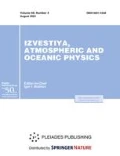Abstract
The content of oxygen in the atmospheric air over cities, as well as in living accommodations and both office and industrial premises, is the most important factor determining the health status of citizens. If both the temperature and absolute humidity of surface air are high (as happened in central European Russia in the summer of 2010), the content of atmospheric oxygen is minimum and people may experience symptoms of hypoxia. In large cities, there are additional factors that can make breathing difficult: higher air temperatures (so-called heat islands) and the presence of carbon monoxide and suspended particles in the atmosphere. This leads to an increase in the rates of morbidity and mortality in the urban population under conditions of anomalously hot weather and natural fires.
Similar content being viewed by others
References
Atmosfera. Spravochnik (spravochnye dannye, modeli) (The Atmosphere: A Handbook (Reference Data and Models)), Leningrad: Gidrometeoizdat, 1991.
Bizin, M.A., Popova, S.A., Chankina, O.V., Makarov, V.I., Shinkorenko, M.S., Smolyakov, B.I., and Kutsenogii, K.P., Impact of forest fires on the mass concentration, particle-size distribution, and chemical composition of atmospheric aerosol in the regional scale, Opt. Atmos. Okeana, 2013, vol. 26, no. 6, pp. 484–489.
Directorate of Civil Registry of Moscow. http://www.zags.mos.ru/information/
Directorate of Civil Registry of the Novosibirsk Region. http://www.zags.nso.ru.
Department of Civil Registry of the Tomsk Region. http://www.zags.tomsk.gov.ru/.
Fang, Y., Naik, V., Horowitz, L.W., and Mauzerall, D.L., Air pollution and associated human mortality: The role of air pollutant emissions, climate change and methane concentration increases from the preindustrial period to present, Atmos. Chem. Phys., 2013, vol. 13, pp. 1377–1394.
Ginzburg, A., Vinogradova, A., and Fedorova, E., Urban residents breathing problems during heat waves and suburb fires episodes, Proc. of the 2nd Int. Conf. “Pollution and Environment-Treatment of Air (PETrA-2013)” (CD-ROM).
Gipoksiya. Adaptatsiya, patogenez, klinika (Hypoxia. Adaptation, Pathogenesis, and Clinics), Shevchenko, Yu.L., Ed., St. Petersburg: Elbi-SPB, 2000.
General Directorate of Civil Registry of the Moscow Region. http://www.zags.mosreg.ru/statistics/.
Mosecomonitoring. http://www.mosecom.ru/air/.
Nikberg, I.I., Revutskii, E.L., and Sakali, L.I., Geliometeotropnye reaktsii cheloveka (Human Heliometeotropic Reactions), Kiev: Zdorov’e, 1986.
Oksid ugleroda. Rossiiskaya entsiklopediya po okhrane truda (Carbon Monoxide. Russian Encyclopedia on Occupational Safety), Safonov, A.L., Ed., Moscow: NTs ENAS, 2007, vol. 2.
Otravlenie monooksidom ugleroda (ugarnym gazom) (Intoxication by Carbon Monoxide), Zobnin, Yu.V., Ed., St. Petersburg: Taktik-Studio, 2011.
Ovcharova, V.F., Homeokinesis in weather hypoxia and hyperoxia, Proc. of the Int. Symp. WMO/WHO/UNEP in the USSR, Leningrad, September 22–26, 1986, Leningrad: Gidrometeoizdat, 1988, vol. 2.
Revich, B.A., The 2010 hot summer and death rate of the population in the European part of Russia, in Book of Abstracts of the All-Russian Meeting “The State of Moscow Air Basin under Extreme Weather Conditions of 2010 Summer,” Moscow, 2010, pp. 91–92.
Sitnov, S.A., Aerosol optical thickness and the total carbon monoxide content over the European Russia territory in the 2010 summer period of mass fires: Interrelation between the variation in pollutants and meteorological parameters, Izv., Atmos. Ocean. Phys., 2011, vol. 47, no. 6, pp. 714–728.
Steinbach, J., Enhancing the usability of atmospheric oxygen measurements through emission source characterization and airborne measurements, Dissertation Dr. Rer. Nat., 2010.
Tiunov, L.A. and Kustov, V.V., Toksikologiya okisi ugleroda (The Toxicology of Carbon Monoxide), Moscow: Meditsina, 1980.
Weather in the World. http://www.rp5.ru.
Yausheva, E.P., Kozlov, V.S., Panchenko, M.V., Terpugova, S.A., Chernov, D.G., and Shmargunov, V.P., Influence of large forest fires in summer 2012 on optical and microphysical characteristics of surface aerosol, Proc. of the 19th Int. Symp. “Atmospheric and Oceanic Optics. Atmosferic Physics,” July 1–6, 2013, Altai (Barnaul-Lake Teletskoe), 2013, pp. 115–119.
Zamolodchikov, D.G., Oxygen the basis of life, Vestn. Ross. Akad. Nauk, 2006, vol. 76, no. 3, pp. 209–218.
Author information
Authors and Affiliations
Corresponding author
Additional information
Original Russian Text © A.S. Ginzburg, A.A. Vinogradova, E.I. Fedorova, E.V. Nikitich, A.V. Karpov, 2014, published in Geofizicheskie Protsessy i Biosfera, 2014, Vol. 13, No. 2, pp. 5–19.
Rights and permissions
About this article
Cite this article
Ginzburg, A.S., Vinogradova, A.A., Fedorova, E.I. et al. Content of oxygen in the atmosphere over large cities and respiratory problems. Izv. Atmos. Ocean. Phys. 50, 782–792 (2014). https://doi.org/10.1134/S0001433814080040
Published:
Issue Date:
DOI: https://doi.org/10.1134/S0001433814080040




